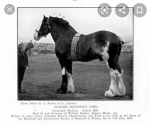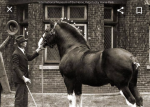scrat
Well-Known Member
Beautifully filmed and available on bbc iplayer https://www.bbc.co.uk/programmes/m000qt61
Enjoy
Enjoy
It didn't really address the elephant in the room, though. How can you preserve a breed when the market for that breed is tiny? Very few people use horses to pull heavy sh1t nowadays, which is what drafts excel at. The mechanization of transport and agriculture is a pretty insurmountable problem. All the heavy drafts are in similar boats -- Shires, Belgians, Percherons, Suffolk Punch, etc. Breeders ultimately need to be able to sell horses, after all, but the horse market has increasingly turned to pets and sporthorses. Drafts aren't ideal as either. A few enthusiasts will buy Shires and Clydes as happy hackers and low level competition horses, but most of us don't actually want an 18hh draft. I sure don't. Given the horses I see at my yard and others, no one else does, either.
I want to see those breeds preserved as much as anybody, but it's going to take a lot more than some breeders hanging out at the SECC in Glasgow and importing a few horses from the US. You need to be able to breed *enough* horses to increase the gene pool. Unless someone is subsizing the breeders, someone has to be keen to buy the horses.
I agree with this they are not ideal hacks and many have extremely poor hocks for a riding horse in fact once they became show pieces they bred cow hocks into them all about having a narrow horse for ploughing .
They are also often not the easiest horses I used to get lesson with someone who broke a lot of them for carriage work pulling drays and the like and he said they where often difficult and not to be completely trusted .
I adore some people adore them but to me they don’t scream riding horse.
Theres a reason the ID is the successful draught breed surviving the Irish started developing their dual purpose traits along time ago .
The answer for ex racers was to create a market with ROR competitions. It made them worth buying for the competition and the competitions showcased that TBs are often great horses for amateurs.
If there was a heavy driving championships with significant prize money and cudos, then maybe it would create a bigger market and encourage the right type of horse to be bred in bigger numbers?
The difference between Clydes and TBs is that a good TB is a very useful animal to a lot of horse people. A horse that's bred to pull and not be ridden, not so much.
Aye, as YCBM says, if one could create a larger, more visible driving scene, you might create more interest in those horses. The US has kind of done this. There's weight-pulling competitions at most of the stock shows, along with opportunities to exhibit and show large hitches. They're nowhere near as popular as ridden horse stuff, but they are more common there than here. Might explain why the American Clydes are in slightly better shape, as a breed, than UK ones.
The difference between Clydes and TBs is that a good TB is a very useful animal to a lot of horse people. A horse that's bred to pull and not be ridden, not so much.
Aye, as YCBM says, if one could create a larger, more visible driving scene, you might create more interest in those horses. The US has kind of done this. There's weight-pulling competitions at most of the stock shows, along with opportunities to exhibit and show large hitches. They're nowhere near as popular as ridden horse stuff, but they are more common there than here. Might explain why the American Clydes are in slightly better shape, as a breed, than UK ones.
Were they always so tall though? I though traditionally they were smaller about 15.2-16hh. Would there be more of a market for a 16h draught with better hocks and temperament? Breeds are often improved, maybe they could be improved in an amateur riding direction? Or dual purpose like the ID. I see little point in continuing down a path that is neither fit for purpose nor ideal for longevity and soundness.
I love a good Clydie but they can be sharp and sensitive and the more modern tall leggy types are not weight carriers at all and often not good doers.
what happens when you work out how to upload photos....
Oh you're right and I doubt anything will happen but it does seem a bit of a shame.I mean, there would definitely be a market for a 16hh weight carrier which was safe enough for an average leisure rider to enjoy. But I'm not sure how easy it would be to get the Clydesdale there, and if it would still be recognisable as the same breed to enthusiasts?


I had a 15/16th TB, 1/16th Clydesdale mare, bred in Aberdeenshire. She was a cracking horse - hunting/pony club/eventing etc. I bred her to a TB, and got another fantastic mare, which I bred back to a TB again. I now have a very nice almost TB ( 1/64th Clydesdale?) with a coat like a yak in the winter, and hocks straighter than either of maternal parents, or his dadBut he's still a very useful sort, who moves like a dream and jumps really well.
I would have another part bred Clydesdale a heart beat!
Just think how much money it would cost for suitable transport for a couple of Clydesdales and a large carriage and all the harness you would need three people .
And what can you do with a Clydesdales driving that’s can’t be done easier with smaller dual purpose horses the answer is pulling a dray and there’s limited fun in that .
Transport is a considerable issue for developing driving as a sport .
If I could drive a anything I would drive small Oldenburgs and ride them as well or perhaps a pair of matching Knapstuppers .
I have a Suffolk and I've been lucky enough to ride a Shire and a Clydesdale.
My Suffolk is an amazing happy hacker. He is calm dependable and polite, very easy to look after and I don't need to rug or worry about complex feeding regimes.
The shire was like my Suffolk but a bit lighter and thinner. She was a polite, well schooled horse who could do anything.
The Clydesdale was something else. He was so light on his feet, endless power and control. He would collect with the lightest feel. As responsive as the best dressage horse I've ever ridden.
The best of all 3 is thay they are so big, they've been bred for intelligence and temperament to make them safe and easy to live with.
I'm interested to see how the current projects to cross breed Suffolks to create good traditional 'heavy types' goes. I know dressage and other WB mares have been put to Jensen. The idea being, to create a market for a good cross you also have to propagate the pure lines for future crosses.
Think how much I save simply because I can't buy stuff in tack shops on a whim (nothing fits him).But agree with others, the sheer expense of keeping a heavy horse, shoes, land, transport, tack etc that puts them out of reach of many would be supporters.